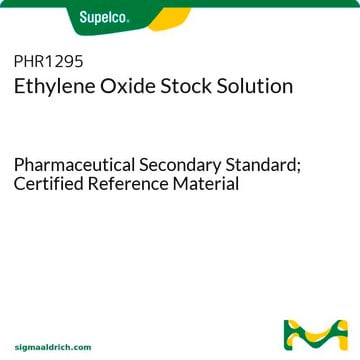56671
Óxido de (±)-propileno
analytical standard
Sinónimos:
(±)-Metiloxirano, 1,2-Epoxipropano
About This Item
Productos recomendados
grado
analytical standard
Nivel de calidad
densidad de vapor
2 (vs air)
presión de vapor
29.43 psi ( 55 °C)
8.59 psi ( 20 °C)
Análisis
≥99.7% (GC)
temp. de autoignición
1378 °F
caducidad
limited shelf life, expiry date on the label
lim. expl.
37 %
técnicas
HPLC: suitable
gas chromatography (GC): suitable
índice de refracción
n20/D 1.366 (lit.)
n20/D 1.366
bp
34 °C (lit.)
mp
−112 °C (lit.)
densidad
0.83 g/mL at 25 °C (lit.)
aplicaciones
cleaning products
cosmetics
environmental
food and beverages
personal care
formato
neat
temp. de almacenamiento
2-8°C
cadena SMILES
CC1CO1
InChI
1S/C3H6O/c1-3-2-4-3/h3H,2H2,1H3
Clave InChI
GOOHAUXETOMSMM-UHFFFAOYSA-N
¿Está buscando productos similares? Visita Guía de comparación de productos
Descripción general
Aplicación
Aplicación
Palabra de señalización
Danger
Frases de peligro
Consejos de prudencia
Clasificaciones de peligro
Acute Tox. 3 Dermal - Acute Tox. 3 Inhalation - Acute Tox. 4 Oral - Carc. 1B - Eye Irrit. 2 - Flam. Liq. 1 - Muta. 1B - STOT SE 3
Órganos de actuación
Respiratory system
Código de clase de almacenamiento
3 - Flammable liquids
Clase de riesgo para el agua (WGK)
WGK 3
Punto de inflamabilidad (°F)
-36.4 °F - Equilibrium method
Punto de inflamabilidad (°C)
-38 °C - Equilibrium method
Equipo de protección personal
Faceshields, Gloves, Goggles
Choose from one of the most recent versions:
¿Ya tiene este producto?
Encuentre la documentación para los productos que ha comprado recientemente en la Biblioteca de documentos.
Los clientes también vieron
Nuestro equipo de científicos tiene experiencia en todas las áreas de investigación: Ciencias de la vida, Ciencia de los materiales, Síntesis química, Cromatografía, Analítica y muchas otras.
Póngase en contacto con el Servicio técnico










